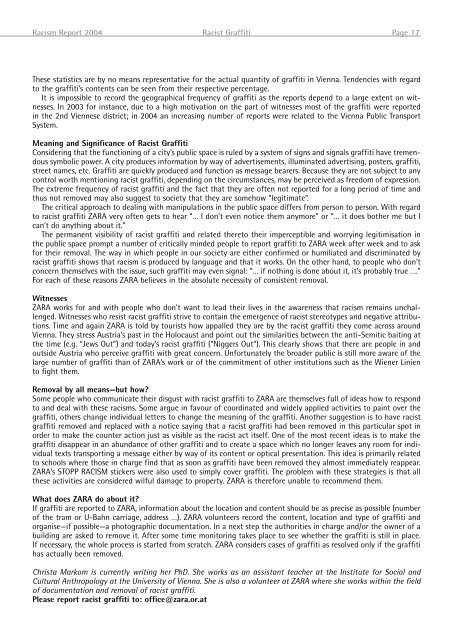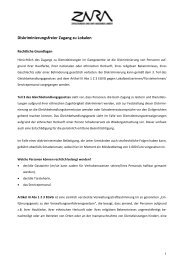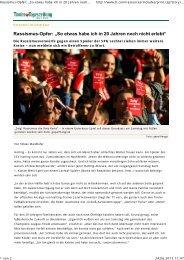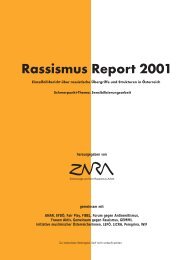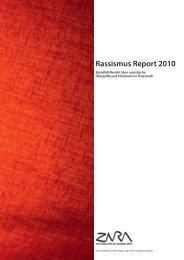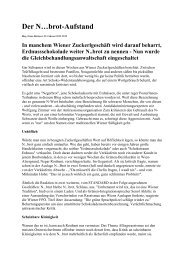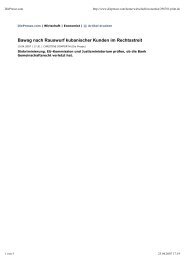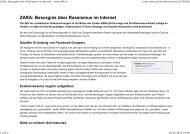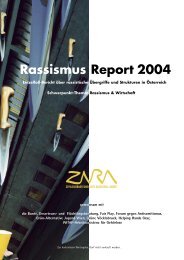"Racism Report 2004" is available for free - Zara
"Racism Report 2004" is available for free - Zara
"Racism Report 2004" is available for free - Zara
- TAGS
- zara
- zara.or.at
You also want an ePaper? Increase the reach of your titles
YUMPU automatically turns print PDFs into web optimized ePapers that Google loves.
<strong>Rac<strong>is</strong>m</strong> <strong>Report</strong> 2004 Rac<strong>is</strong>t Graffiti Page 17<br />
These stat<strong>is</strong>tics are by no means representative <strong>for</strong> the actual quantity of graffiti in Vienna. Tendencies with regard<br />
to the graffiti’s contents can be seen from their respective percentage.<br />
It <strong>is</strong> impossible to record the geographical frequency of graffiti as the reports depend to a large extent on witnesses.<br />
In 2003 <strong>for</strong> instance, due to a high motivation on the part of witnesses most of the graffiti were reported<br />
in the 2nd Viennese d<strong>is</strong>trict; in 2004 an increasing number of reports were related to the Vienna Public Transport<br />
System.<br />
Meaning and Significance of Rac<strong>is</strong>t Graffiti<br />
Considering that the functioning of a city’s public space <strong>is</strong> ruled by a system of signs and signals graffiti have tremendous<br />
symbolic power. A city produces in<strong>for</strong>mation by way of advert<strong>is</strong>ements, illuminated advert<strong>is</strong>ing, posters, graffiti,<br />
street names, etc. Graffiti are quickly produced and function as message bearers. Because they are not subject to any<br />
control worth mentioning rac<strong>is</strong>t graffiti, depending on the circumstances, may be perceived as <strong>free</strong>dom of expression.<br />
The extreme frequency of rac<strong>is</strong>t graffiti and the fact that they are often not reported <strong>for</strong> a long period of time and<br />
thus not removed may also suggest to society that they are somehow “legitimate”.<br />
The critical approach to dealing with manipulations in the public space differs from person to person. With regard<br />
to rac<strong>is</strong>t graffiti ZARA very often gets to hear “… I don’t even notice them anymore” or “… it does bother me but I<br />
can’t do anything about it.”<br />
The permanent v<strong>is</strong>ibility of rac<strong>is</strong>t graffiti and related thereto their imperceptible and worrying legitim<strong>is</strong>ation in<br />
the public space prompt a number of critically minded people to report graffiti to ZARA week after week and to ask<br />
<strong>for</strong> their removal. The way in which people in our society are either confirmed or humiliated and d<strong>is</strong>criminated by<br />
rac<strong>is</strong>t graffiti shows that rac<strong>is</strong>m <strong>is</strong> produced by language and that it works. On the other hand, to people who don’t<br />
concern themselves with the <strong>is</strong>sue, such graffiti may even signal: “… if nothing <strong>is</strong> done about it, it’s probably true ….”<br />
For each of these reasons ZARA believes in the absolute necessity of cons<strong>is</strong>tent removal.<br />
Witnesses<br />
ZARA works <strong>for</strong> and with people who don’t want to lead their lives in the awareness that rac<strong>is</strong>m remains unchallenged.<br />
Witnesses who res<strong>is</strong>t rac<strong>is</strong>t graffiti strive to contain the emergence of rac<strong>is</strong>t stereotypes and negative attributions.<br />
Time and again ZARA <strong>is</strong> told by tour<strong>is</strong>ts how appalled they are by the rac<strong>is</strong>t graffiti they come across around<br />
Vienna. They stress Austria’s past in the Holocaust and point out the similarities between the anti-Semitic baiting at<br />
the time (e.g. “Jews Out”) and today’s rac<strong>is</strong>t graffiti (“Niggers Out”). Th<strong>is</strong> clearly shows that there are people in and<br />
outside Austria who perceive graffiti with great concern. Un<strong>for</strong>tunately the broader public <strong>is</strong> still more aware of the<br />
large number of graffiti than of ZARA’s work or of the commitment of other institutions such as the Wiener Linien<br />
to fight them.<br />
Removal by all means—but how?<br />
Some people who communicate their d<strong>is</strong>gust with rac<strong>is</strong>t graffiti to ZARA are themselves full of ideas how to respond<br />
to and deal with these rac<strong>is</strong>ms. Some argue in favour of coordinated and widely applied activities to paint over the<br />
graffiti, others change individual letters to change the meaning of the graffiti. Another suggestion <strong>is</strong> to have rac<strong>is</strong>t<br />
graffiti removed and replaced with a notice saying that a rac<strong>is</strong>t graffiti had been removed in th<strong>is</strong> particular spot in<br />
order to make the counter action just as v<strong>is</strong>ible as the rac<strong>is</strong>t act itself. One of the most recent ideas <strong>is</strong> to make the<br />
graffiti d<strong>is</strong>appear in an abundance of other graffiti and to create a space which no longer leaves any room <strong>for</strong> individual<br />
texts transporting a message either by way of its content or optical presentation. Th<strong>is</strong> idea <strong>is</strong> primarily related<br />
to schools where those in charge find that as soon as graffiti have been removed they almost immediately reappear.<br />
ZARA’s STOPP RACISM stickers were also used to simply cover graffiti. The problem with these strategies <strong>is</strong> that all<br />
these activities are considered wilful damage to property. ZARA <strong>is</strong> there<strong>for</strong>e unable to recommend them.<br />
What does ZARA do about it?<br />
If graffiti are reported to ZARA, in<strong>for</strong>mation about the location and content should be as prec<strong>is</strong>e as possible (number<br />
of the tram or U-Bahn carriage, address …). ZARA volunteers record the content, location and type of graffiti and<br />
organ<strong>is</strong>e—if possible—a photographic documentation. In a next step the authorities in charge and/or the owner of a<br />
building are asked to remove it. After some time monitoring takes place to see whether the graffiti <strong>is</strong> still in place.<br />
If necessary, the whole process <strong>is</strong> started from scratch. ZARA considers cases of graffiti as resolved only if the graffiti<br />
has actually been removed.<br />
Chr<strong>is</strong>ta Markom <strong>is</strong> currently writing her PhD. She works as an ass<strong>is</strong>tant teacher at the Institute <strong>for</strong> Social and<br />
Cultural Anthropology at the University of Vienna. She <strong>is</strong> also a volunteer at ZARA where she works within the field<br />
of documentation and removal of rac<strong>is</strong>t graffiti.<br />
Please report rac<strong>is</strong>t graffiti to: office@zara.or.at


